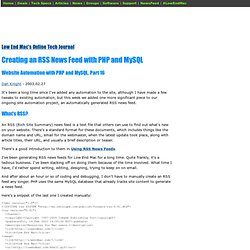

Mac, Apache, MySQL, PHP. Untitled. PHP Login System with Admin Features. Introduction I wrote the popular evolt.org tutorial PHP Login Script with Remember Me Feature mainly as an introduction to user sessions and cookies in PHP.

Since it was created as a learning tool, many advanced features were left out of the script. By popular demand, I have written and am presenting here a complete Login System, with all the features that were left out of the first script, that can be easily integrated into any website. Notes This article is intended primarily for intermediate to advanced users of PHP, as it is not exactly a tutorial, but a description of the implementation of an advanced Login System. Features Here are some of the features in this Login System that weren't included in the initial tutorial:Better Security - Passwords are not stored in cookies, randomly generated ids take their place.Member Levels - Now users can be differentiated by what level they are (user, admin, etc.)Admin Center - As an admin, you have full control over registered users.
Database <? <? Creating an RSS News Feed with PHP and MySQL. Dan Knight - 2003.02.27 It's been a long time since I've added any automation to the site, although I have made a few tweaks to existing automation, but this week we added one more significant piece to our ongoing site automation project, an automatically generated RSS news feed.

What's RSS? An RSS (Rich Site Summary) news feed is a text file that others can use to find out what's new on your website. There's a standard format for these documents, which includes things like the domain name and URL, email for the webmaster, when the latest update took place, along with article titles, their URL, and usually a brief description or teaser. There's a good introduction to them in Using RSS News Feeds.
I've been generating RSS news feeds for Low End Mac for a long time. And after about an hour or so of coding and debugging, I don't have to manually create an RSS feed any longer. MySQL Help, MySQL Tutorials, MySQL Programming, MySQL Tricks. PHP and XML: Parsing RSS 1.0. XML is springing up all over the Internet as a means to create standard data formats for the exchange of information between systems, irrelevant of their platform or technology.

As you may already know, XML allows you to define your own custom markup languages similar to HTML and suited to whatever data you need to represent. A number of standard XML-based markup languages have been created to facilitate the exchange of common types of information. In this article, we’ll learn how to use PHP to read an XML document and display the data it contains as a Web page. The example we’ll use is a Resource Description Framework (RDF) Site Summary (RSS) 1.0 document, although the techniques presented here apply to any situation where you wish to parse XML data in a PHP script. A Brief Tour Of RSS 1.0 As with most XML document formats, the meaning of the document can be gleaned fairly easily simply by looking over a sample document.
PHP’s Take on XML PHP uses an event-based API to process XML.